transmission YAMAHA XT660Z 2015 Owners Manual
[x] Cancel search | Manufacturer: YAMAHA, Model Year: 2015, Model line: XT660Z, Model: YAMAHA XT660Z 2015Pages: 98, PDF Size: 8.44 MB
Page 12 of 98

SAFETY INFORMATION
1-5
1Aftermarket Tires and Rims
The tires and rims that came with your
motorcycle were designed to match
the performance capabilities and to
provide the best combination of han-
dling, braking, and comfort. Other
tires, rims, sizes, and combinations
may not be appropriate. Refer to page
6-17 for tire specifications and more in-
formation on replacing your tires.
Transporting the Motorcycle
Be sure to observe following instruc-
tions before transporting the motorcy-
cle in another vehicle.
Remove all loose items from the
motorcycle.
Check that the fuel cock (if
equipped) is in the “OFF” position
and that there are no fuel leaks.
Point the front wheel straight
ahead on the trailer or in the truck
bed, and choke it in a rail to pre-
vent movement.
Shift the transmission in gear (for
models with a manual transmis-
sion).Secure the motorcycle with tie-
downs or suitable straps that are
attached to solid parts of the mo-
torcycle, such as the frame or up-
per front fork triple clamp (and not,
for example, to rubber-mounted
handlebars or turn signals, or
parts that could break). Choose
the location for the straps carefully
so the straps will not rub against
painted surfaces during transport.
The suspension should be com-
pressed somewhat by the tie-
downs, if possible, so that the mo-
torcycle will not bounce exces-
sively during transport.
U2BDE1E0.book Page 5 Tuesday, December 16, 2014 5:38 PM
Page 21 of 98
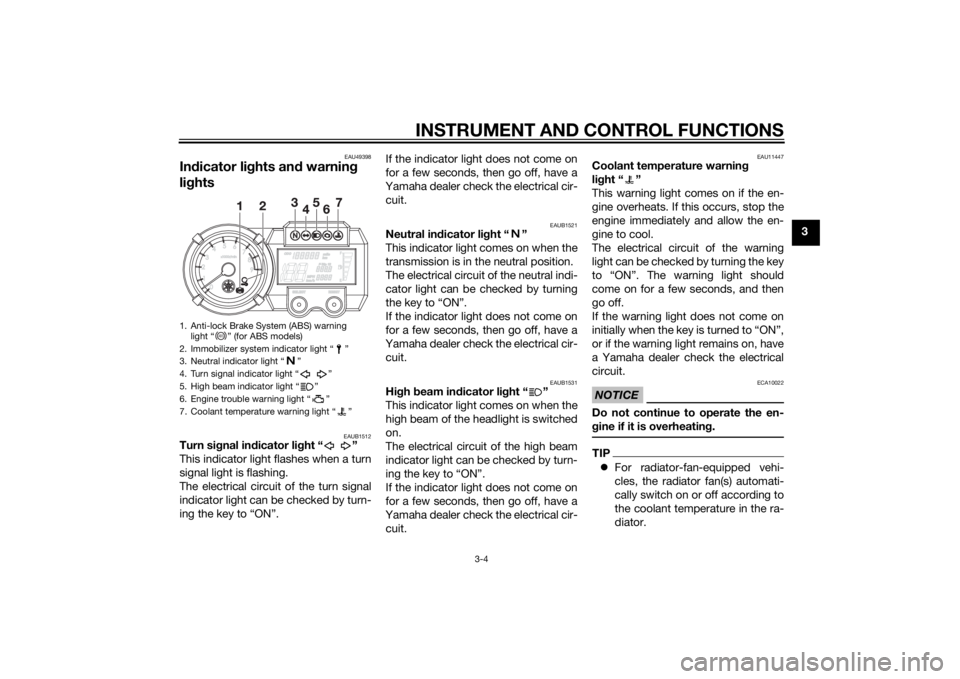
INSTRUMENT AND CONTROL FUNCTIONS
3-4
3
EAU49398
Indicator lights and warning
lights
EAUB1512
Turn signal indicator light “ ”
This indicator light flashes when a turn
signal light is flashing.
The electrical circuit of the turn signal
indicator light can be checked by turn-
ing the key to “ON”.If the indicator light does not come on
for a few seconds, then go off, have a
Yamaha dealer check the electrical cir-
cuit.
EAUB1521
Neutral indicator light “ ”
This indicator light comes on when the
transmission is in the neutral position.
The electrical circuit of the neutral indi-
cator light can be checked by turning
the key to “ON”.
If the indicator light does not come on
for a few seconds, then go off, have a
Yamaha dealer check the electrical cir-
cuit.
EAUB1531
High beam indicator light “ ”
This indicator light comes on when the
high beam of the headlight is switched
on.
The electrical circuit of the high beam
indicator light can be checked by turn-
ing the key to “ON”.
If the indicator light does not come on
for a few seconds, then go off, have a
Yamaha dealer check the electrical cir-
cuit.
EAU11447
Coolant temperature warning
light “ ”
This warning light comes on if the en-
gine overheats. If this occurs, stop the
engine immediately and allow the en-
gine to cool.
The electrical circuit of the warning
light can be checked by turning the key
to “ON”. The warning light should
come on for a few seconds, and then
go off.
If the warning light does not come on
initially when the key is turned to “ON”,
or if the warning light remains on, have
a Yamaha dealer check the electrical
circuit.NOTICE
ECA10022
Do not continue to operate the en-
gine if it is overheating.TIPFor radiator-fan-equipped vehi-
cles, the radiator fan(s) automati-
cally switch on or off according to
the coolant temperature in the ra-
diator.
1. Anti-lock Brake System (ABS) warning
light “ ” (for ABS models)
2. Immobilizer system indicator light “ ”
3. Neutral indicator light “ ”
4. Turn signal indicator light “ ”
5. High beam indicator light “ ”
6. Engine trouble warning light “ ”
7. Coolant temperature warning light “ ”
ABS
U2BDE1E0.book Page 4 Tuesday, December 16, 2014 5:38 PM
Page 28 of 98
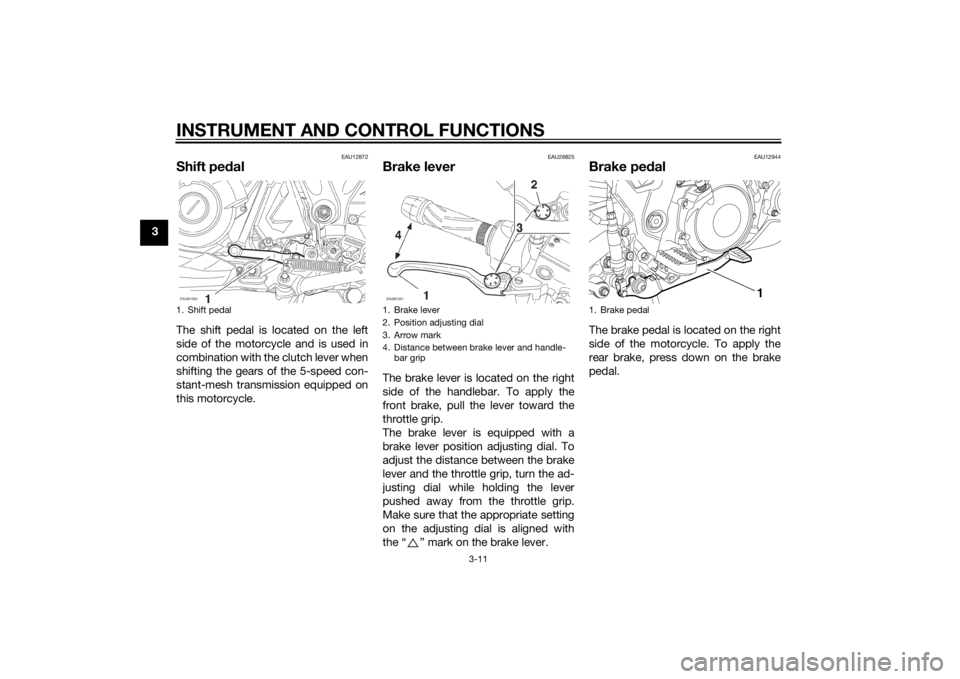
INSTRUMENT AND CONTROL FUNCTIONS
3-11
3
EAU12872
Shift pedalThe shift pedal is located on the left
side of the motorcycle and is used in
combination with the clutch lever when
shifting the gears of the 5-speed con-
stant-mesh transmission equipped on
this motorcycle.
EAU26825
Brake leverThe brake lever is located on the right
side of the handlebar. To apply the
front brake, pull the lever toward the
throttle grip.
The brake lever is equipped with a
brake lever position adjusting dial. To
adjust the distance between the brake
lever and the throttle grip, turn the ad-
justing dial while holding the lever
pushed away from the throttle grip.
Make sure that the appropriate setting
on the adjusting dial is aligned with
the “ ” mark on the brake lever.
EAU12944
Brake pedalThe brake pedal is located on the right
side of the motorcycle. To apply the
rear brake, press down on the brake
pedal.
1. Shift pedalZAUM1260
1. Brake lever
2. Position adjusting dial
3. Arrow mark
4. Distance between brake lever and handle-
bar grip
11
1
ZAUM1251
1. Brake pedal
U2BDE1E0.book Page 11 Tuesday, December 16, 2014 5:38 PM
Page 36 of 98
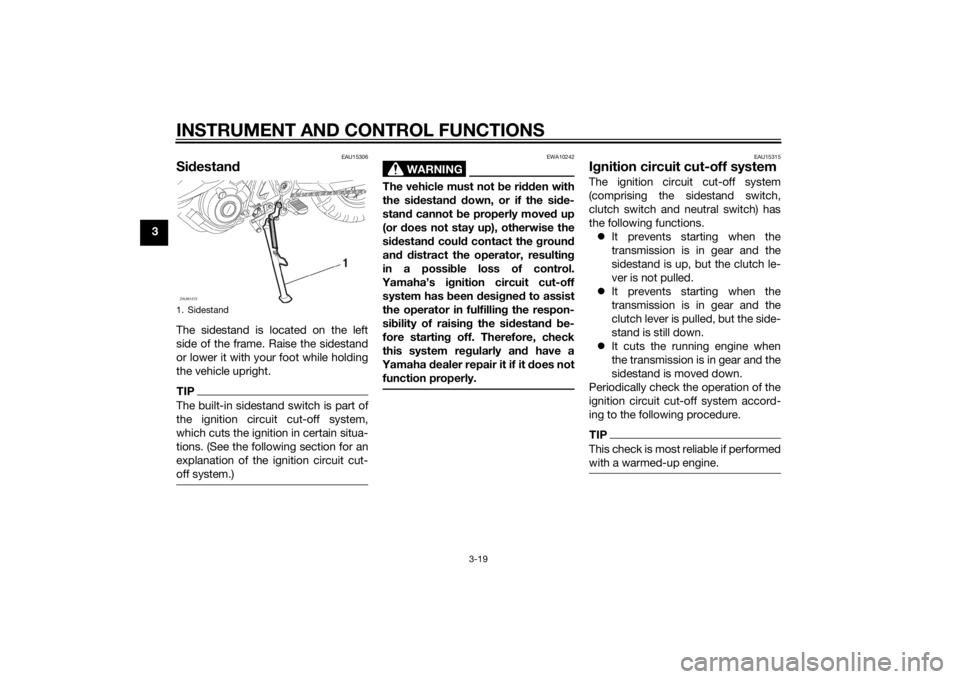
INSTRUMENT AND CONTROL FUNCTIONS
3-19
3
EAU15306
SidestandThe sidestand is located on the left
side of the frame. Raise the sidestand
or lower it with your foot while holding
the vehicle upright.TIPThe built-in sidestand switch is part of
the ignition circuit cut-off system,
which cuts the ignition in certain situa-
tions. (See the following section for an
explanation of the ignition circuit cut-
off system.)
WARNING
EWA10242
The vehicle must not be ridden with
the sidestand down, or if the side-
stand cannot be properly moved up
(or does not stay up), otherwise the
sidestand could contact the ground
and distract the operator, resulting
in a possible loss of control.
Yamaha’s ignition circuit cut-off
system has been designed to assist
the operator in fulfilling the respon-
sibility of raising the sidestand be-
fore starting off. Therefore, check
this system regularly and have a
Yamaha dealer repair it if it does not
function properly.
EAU15315
Ignition circuit cut-off systemThe ignition circuit cut-off system
(comprising the sidestand switch,
clutch switch and neutral switch) has
the following functions.
It prevents starting when the
transmission is in gear and the
sidestand is up, but the clutch le-
ver is not pulled.
It prevents starting when the
transmission is in gear and the
clutch lever is pulled, but the side-
stand is still down.
It cuts the running engine when
the transmission is in gear and the
sidestand is moved down.
Periodically check the operation of the
ignition circuit cut-off system accord-
ing to the following procedure.TIPThis check is most reliable if performed
with a warmed-up engine.
1. SidestandZAUM1272
U2BDE1E0.book Page 19 Tuesday, December 16, 2014 5:38 PM
Page 37 of 98

INSTRUMENT AND CONTROL FUNCTIONS
3-20
3
With the engine turned off:
1. Move the sidestand down.
2. Make sure that the engine stop switch is set to “
3. Turn the key on.
4. Shift the transmission into the neutral position.
5. Push the start switch.
Does the engine start?
With the engine still running:
6. Move the sidestand up.
7. Keep the clutch lever pulled.
8. Shift the transmission into gear.
9. Move the sidestand down.
Does the engine stall?
After the engine has stalled:
10. Move the sidestand up.
11. Keep the clutch lever pulled.
12. Push the start switch.
Does the engine start?
The system is OK. The motorcycle can be ridden.The neutral switch may not be working correctly.
The motorcycle should not be ridden until
checked by a Yamaha dealer.
The sidestand switch may not be working correctly.
The motorcycle should not be ridden until
checked by a Yamaha dealer.
The clutch switch may not be working correctly.
The motorcycle should not be ridden until
checked by a Yamaha dealer.
YES NO YES NO YES NO
If a malfunction is noted, have a Yamaha
dealer check the system before riding.
WARNING
”.
U2BDE1E0.book Page 20 Tuesday, December 16, 2014 5:38 PM
Page 41 of 98

OPERATION AND IMPORTANT RIDING POINTS
5-1
5
EAU15952
Read the Owner’s Manual carefully to
become familiar with all controls. If
there is a control or function you do not
understand, ask your Yamaha dealer.
WARNING
EWA10272
Failure to familiarize yourself with
the controls can lead to loss of con-
trol, which could cause an accident
or injury.
EAU48021
TIPThis model is equipped with a lean an-
gle sensor to stop the engine in case of
a turnover. In this case, the multi-func-
tion display indicates error code 30,
but this is not a malfunction. Turn the
the error code. Failing to do so will pre-
vent the engine from starting even
though the engine will crank when
pushing the start switch.
EAUS1952
Starting the engineIn order for the ignition circuit cut-off
system to enable starting, one of the
following conditions must be met:
The transmission is in the neutral
position.
The transmission is in gear with
the clutch lever pulled and the
sidestand up.
WARNING
EWA10291
Before starting the engine,
check the function of the igni-
tion circuit cut-off system ac-
cording to the procedure
described on page 3-19.
Never ride with the sidestand
down.1. Turn the key to “ON” and make
sure that the engine stop switch is
set to “ ”.NOTICE
ECAS0041
The following warning lights and in-
dicator lights should come on for a
few seconds, then go off.
Neutral indicator light
Turn signal indicator light
U2BDE1E0.book Page 1 Tuesday, December 16, 2014 5:38 PM
Page 42 of 98
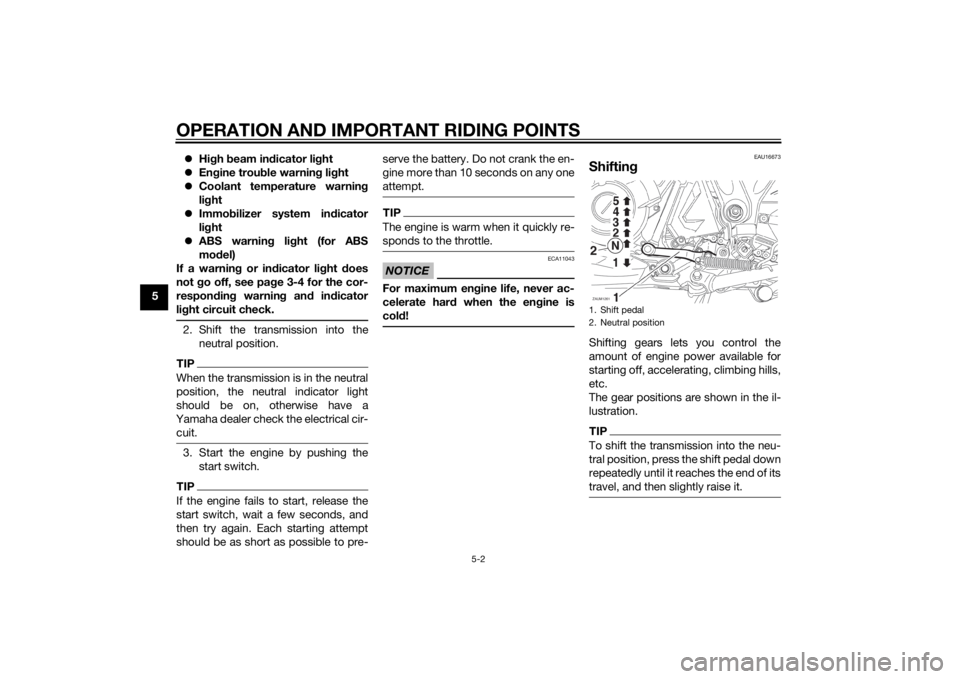
OPERATION AND IMPORTANT RIDING POINTS
5-2
5High beam indicator light
Engine trouble warning light
Coolant temperature warning
light
Immobilizer system indicator
light
ABS warning light (for ABS
model)
If a warning or indicator light does
not go off, see page 3-4 for the cor-
responding warning and indicator
light circuit check.
2. Shift the transmission into the
neutral position.TIPWhen the transmission is in the neutral
position, the neutral indicator light
should be on, otherwise have a
Yamaha dealer check the electrical cir-
cuit.3. Start the engine by pushing the
start switch.TIPIf the engine fails to start, release the
start switch, wait a few seconds, and
then try again. Each starting attempt
should be as short as possible to pre-serve the battery. Do not crank the en-
gine more than 10 seconds on any one
attempt.
TIPThe engine is warm when it quickly re-
sponds to the throttle.NOTICE
ECA11043
For maximum engine life, never ac-
celerate hard when the engine is
cold!
EAU16673
ShiftingShifting gears lets you control the
amount of engine power available for
starting off, accelerating, climbing hills,
etc.
The gear positions are shown in the il-
lustration.TIPTo shift the transmission into the neu-
tral position, press the shift pedal down
repeatedly until it reaches the end of its
travel, and then slightly raise it.1. Shift pedal
2. Neutral positionZAUM12612
U2BDE1E0.book Page 2 Tuesday, December 16, 2014 5:38 PM
Page 43 of 98

OPERATION AND IMPORTANT RIDING POINTS
5-3
5
NOTICE
ECA10261
Even with the transmission in
the neutral position, do not
coast for long periods of time
with the engine off, and do not
tow the motorcycle for long dis-
tances. The transmission is
properly lubricated only when
the engine is running. Inade-
quate lubrication may damage
the transmission.
Always use the clutch while
changing gears to avoid dam-
aging the engine, transmission,
and drive train, which are not
designed to withstand the
shock of forced shifting.
EAU16811
Tips for reducing fuel con-
sumptionFuel consumption depends largely on
your riding style. Consider the follow-
ing tips to reduce fuel consumption:
Shift up swiftly, and avoid high en-
gine speeds during acceleration.
Do not rev the engine while shift-
ing down, and avoid high engine
speeds with no load on the en-
gine.
Turn the engine off instead of let-
ting it idle for an extended length
of time (e.g., in traffic jams, at traf-
fic lights or at railroad crossings).
EAU16842
Engine break-inThere is never a more important period
in the life of your engine than the period
between 0 and 1600 km (1000 mi). For
this reason, you should read the fol-
lowing material carefully.
Since the engine is brand new, do not
put an excessive load on it for the first
1600 km (1000 mi). The various parts in
the engine wear and polish themselves
to the correct operating clearances.
During this period, prolonged full-throt-
tle operation or any condition that
might result in engine overheating
must be avoided.
EAU17103
0–1000 km (0–600 mi)
Avoid prolonged operation above 4500
r/min. NOTICE: After 1000 km (600
mi) of operation, the engine oil must
be changed, and the oil filter ele-
ment replaced.
[ECA11152]
1000–1600 km (600–1000 mi)
Avoid prolonged operation above 6000
r/min.
U2BDE1E0.book Page 3 Tuesday, December 16, 2014 5:38 PM
Page 67 of 98
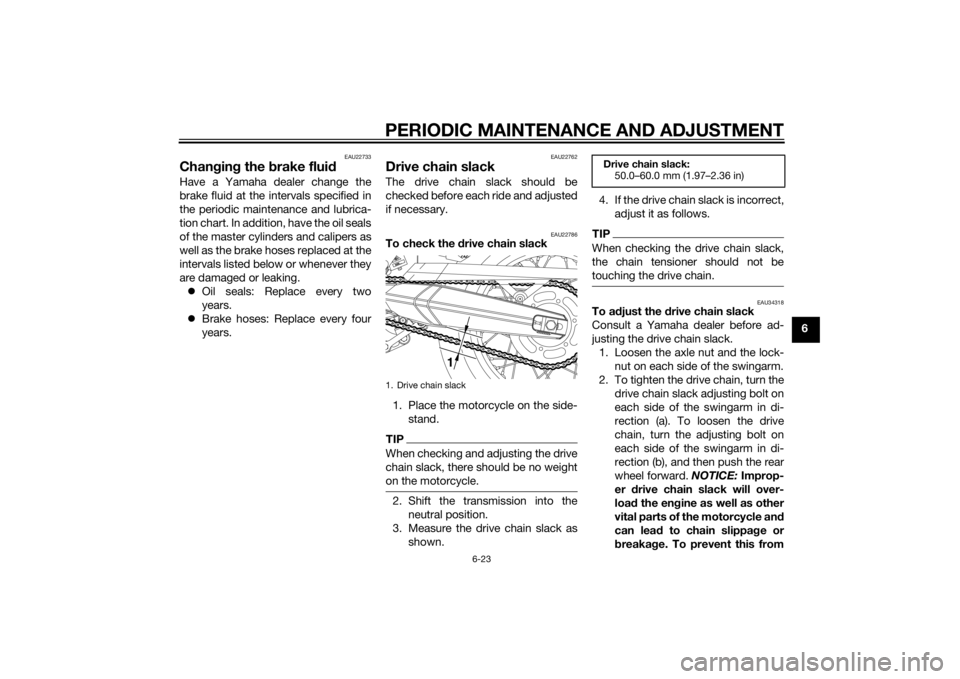
PERIODIC MAINTENANCE AND ADJUSTMENT
6-23
6
EAU22733
Changing the brake fluidHave a Yamaha dealer change the
brake fluid at the intervals specified in
the periodic maintenance and lubrica-
tion chart. In addition, have the oil seals
of the master cylinders and calipers as
well as the brake hoses replaced at the
intervals listed below or whenever they
are damaged or leaking.
Oil seals: Replace every two
years.
Brake hoses: Replace every four
years.
EAU22762
Drive chain slackThe drive chain slack should be
checked before each ride and adjusted
if necessary.
EAU22786
To check the drive chain slack
1. Place the motorcycle on the side-
stand.TIPWhen checking and adjusting the drive
chain slack, there should be no weight
on the motorcycle.2. Shift the transmission into the
neutral position.
3. Measure the drive chain slack as
shown.4. If the drive chain slack is incorrect,
adjust it as follows.
TIPWhen checking the drive chain slack,
the chain tensioner should not be
touching the drive chain.
EAU34318
To adjust the drive chain slack
Consult a Yamaha dealer before ad-
justing the drive chain slack.
1. Loosen the axle nut and the lock-
nut on each side of the swingarm.
2. To tighten the drive chain, turn the
drive chain slack adjusting bolt on
each side of the swingarm in di-
rection (a). To loosen the drive
chain, turn the adjusting bolt on
each side of the swingarm in di-
rection (b), and then push the rear
wheel forward. NOTICE: Improp-
er drive chain slack will over-
load the engine as well as other
vital parts of the motorcycle and
can lead to chain slippage or
breakage. To prevent this from
1. Drive chain slack
Drive chain slack:
50.0–60.0 mm (1.97–2.36 in)
U2BDE1E0.book Page 23 Tuesday, December 16, 2014 5:38 PM
Page 90 of 98

SPECIFICATIONS
8-1
8
Dimensions:Overall length:
2246 mm (88.4 in)
Overall width:
896 mm (35.3 in)
Overall height:
XT660Z 1477 mm (58.1 in)
XT660ZA 1450 mm (57.1 in)
Seat height:
XT660Z 896 mm (35.3 in)
XT660ZA 865 mm (34.1 in)
Wheelbase:
XT660Z 1500 mm (59.1 in)
XT660ZA 1505 mm (59.3 in)
Ground clearance:
XT660Z 260 mm (10.24 in)
XT660ZA 205 mm (8.07 in)
Minimum turning radius:
XT660Z 1958 mm (77.1 in)
XT660ZA 1980 mm (78.0 in)Weight:Curb weight:
XT660Z 206 kg (454 lb)
XT660ZA 215 kg (474 lb)Engine:Engine type:
Liquid cooled 4-stroke, SOHC
Cylinder arrangement:
Single cylinder
Displacement:
660 cm³
Bore × stroke:
100.0 × 84.0 mm (3.94 × 3.31 in)Compression ratio:
10.0 : 1
Starting system:
Electric starter
Lubrication system:
Dry sump
Engine oil:Recommended brand:
YAMALUBE
Type:
SAE 10W-30, 10W-40, 15W-40, 20W-40 or
20W-50
Recommended engine oil grade:
API service SE type or higher, JASO
standard MA
Engine oil quantity:
Without oil filter element replacement:
2.50 L (2.64 US qt, 2.20 Imp.qt)
With oil filter element replacement:
2.60 L (2.75 US qt, 2.29 Imp.qt)
Coolant quantity:Coolant reservoir (up to the maximum level
mark):
0.50 L (0.53 US qt, 0.44 Imp.qt)
Radiator (including all routes):
1.70 L (1.80 US qt, 1.50 Imp.qt)Air filter:Air filter element:
Dry elementFuel:Recommended fuel:
Premium unleaded gasoline only
Fuel tank capacity:
23.0 L (6.07 US gal, 5.06 Imp.gal)
Fuel reserve amount:
XT660Z 6.7 L (1.77 US gal, 1.47 Imp.gal)
XT660ZA 5.8 L (1.53 US gal, 1.28 Imp.gal)Fuel injection:Throttle body:
ID mark:
5YK2 11Spark plug(s):Manufacturer/model:
NGK/CR7E
Spark plug gap:
0.7–0.8 mm (0.028–0.031 in)Clutch:Clutch type:
Wet, multiple-discTransmission:Primary reduction ratio:
75/36 (2.083)
Final drive:
Chain
–20 –10 0
1020 30 40 50 �C 10 30 50 70 90 110 0 130 �F
SAE 10W-30
SAE 15W-40SAE 20W-40SAE 20W-50
SAE 10W-40SAE 10W-50
U2BDE1E0.book Page 1 Tuesday, December 16, 2014 5:38 PM